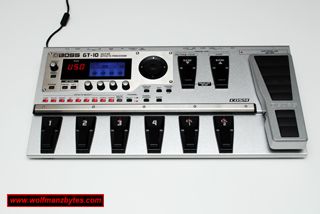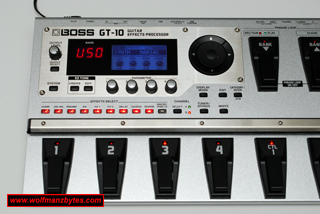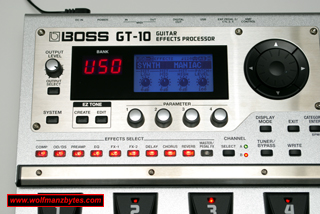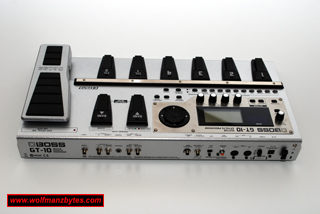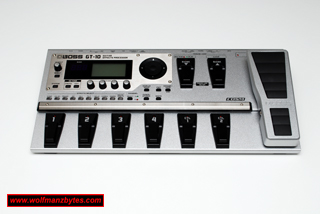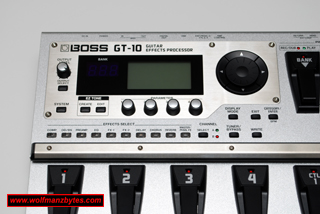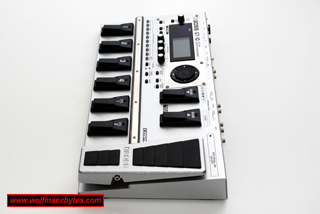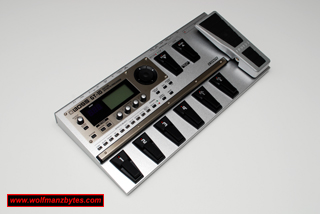
After years of playing acoustic guitar I finally went out and purchased a Fender Telecaster American Standard electric guitar. After purchasing the guitar I also figured it would be a good idea to pick up an effects pedal and this is where the Boss GT-10 comes into the picture.
Before I get into this Review I want to mention the specs of the Boss GT-10 Effects Pedal.
-AD Conversion 24-bit + AF method (*1)
-DA Conversion 24-bit
-Sampling Frequency 44.1 kHz
-Program Memories 400: 200 (user) + 200 (preset)
-Nominal Input Level INPUT: -10 dBu RETURN: -10 dBu
-Input Impedance INPUT: 1 M ohm RETURN: 220 k ohms
-Nominal Output Level OUTPUT: -10 dBu / +4 dBu SEND: -10 dBu
-Output Impedance OUTPUT: 2 k ohms SEND: 3 k ohms
-Dynamic Range 100 dB or greater (IHF-A)
-Digital Output Coaxial type (conforms to IEC60958)
-Display 132 x 64 dots graphic LCD with backlit 7 segments, 3 characters LED
-Connectors INPUT jack (1/4 inch phone type), OUTPUT L/MONO, R jacks (1/4 inch phone type), PHONES jack (Stereo 1/4 inch phone type), EXT LOOP jacks SEND, RETURN (1/4 inch phone type), AMP CONTROL jack (1/4 inch phone type), EXP PEDAL 2/CTL3,4 jack (1/4 inch TRS phone type), USB connector, DIGITAL OUT jack, MIDI connectors IN, OUT, DC IN jack
-Power Supply DC 9 V (AC Adaptor: Roland PSB-1U)
-Current Draw 800 mA
-Accessories AC Adaptor (Roland PSB-1U), Owner’s Manual, Roland Service (Information Sheet)
-Options Footswitch: BOSS FS-5U, Dual Footswitch: BOSS FS-6, Expression Pedal: BOSS FV-500L/500H, Roland EV-5, Footswitch Cable: Roland PCS-31 (1/4 inch phone plug (stereo) - 1/4, inch phone plug (mono) x2)
-Size and Weight Width 542 mm 21-3/8 inches Depth 272 mm 10-3/4 inches Height 77 mm 3-1/16 inches Weight 4.9 kg 10 lbs. 13 oz. Maximum height is 104 mm (4-1/8 inches) when pedal-up
What got me interested in the effects pedals in general was the software effects pedals that come with the Intone software that comes with the M-Audio Fast Track Pro recording interface. After messing around with the Software Effect pedals I thought it would be a good idea to purchase some hardware that could do the same thing and not require the computer to go along with it.
Before buying the Boss GT-10 I had to do some research and see what else was out there in terms of multi effects pedals and the only other effects pedal I could find that was similar to the Boss GT-10 was the Line 6 X3 Live and it was going for the same price as the Boss GT-10. So my choice come down to one of these two pedals and each have their pro’s and con’s. I spent tons of time looking at each pedal and both had a lot of features and both sounded really good.
After spending all the time going over each of these two foot pedals I wasn’t sure which one I wanted. It wasn’t until I went to a local music store to purchase a mic and some recording software that I seen the Boss GT-10 in person. Looking at the Boss GT-10 in person really makes you appreciate how slick this effects pedal looks. The only hitch for me purchasing the pedal was what it was made from. All the stuff I read about the Boss GT-10 never mentioned what it was constructed from. I figured I would buy the Boss GT-10 only if it was made from metal and not plastic. The reason for this choice was simple the Boss GT-10 cost $500.00 Canadian and if I was going to fork out that type cash the pedal had to be made from metal and feel like it was going to last forever.
A guy who worked at the music store confirmed it was indeed made from metal and that was the only thing I needed to know, I then purchased the Boss GT-10 Effects pedal. It’s funny how a pedal like the Boss GT-10 can have all these features for effects and the one thing that made sale was what the pedal was made from. I hate spending a lot of money on stuff that’s built cheaply and soon after buying it starts to fall apart. I’m glad to say after giving the Boss GT-10 a few good knocks every now and again by accident of course the unit still looks and functions just like the day I bought it.
It should be noted that had the store where I bought the Boss GT-10 carried the Line 6 X3 Live and had that on display I may have ended up with it if it was made from metal as well. Both of these effects pedals are so closely matched in what they can do that I would have had a hard choice picking between them if the store had both of them on display. Fortunately for me the store only had the Boss GT-10 and that made my choice rather simple. Having said that I’m trying to get the Line 6 X3 Live in for review as well since I would like to see what it can do in person.
So when I finally made it home with the Boss GT-10 it was time to plug it in and see what it sounds like. The one really good thing I like about this pedal is the fact you can plug headphones in and not annoy other people you live with. Once I plugged it into some power and turned it on you get to see the cool lights and the LCD screen turn on. The one thing I wish I could adjust on this pedal is the brightness of the lights that are on each foot switch these things are super bright. The LCD looks really good and is back lit by a blue light. Below are some pictures of the Boss GT-10 powered up.
Navigating the different effect presets is a breeze and can be done with the Bank foot switches or you can scroll through the effects presets using the scroll wheel that’s beside the LCD display. The amount of presets the Boss GT-10 has is quite stunning, I literally spent 2 days going through the presets and testing them out one by one. That’s one thing I should mention as well if you plan on getting the Boss GT-10 or the Line 6 Live X3 you better have a lot of time on your hands because there is a lot to mess around with.
The Boss GT-10 also comes with an AMP simulator and this is where you can spend a lot of time messing around the Boss GT-10. When you get the AMP simulator up you can select from a list of AMP Heads you want to use for your sound. Along with the AMP heads you can also select what type of speaker cabinet you will be using. Along with the speaker and AMP head selection you also have a choice of what mic to place in front of the speaker. Options like the AMP simulator built into the Boss GT-10 are what blow my mind about this product. You can spend loads of time just messing around with the AMP simulator and never even mind all the other stuff this pedal does.
With any of the presets in the Boss GT-10 you can modify its settings or add and subtract effects from a preset. Say for example there is a certain type of effect you want but it has too much reverb you can either turn the reverb down or turn it off completely. Likewise let’s say you want to add reverb to an effect again you hit the reverb button on the pedal and that will add reverb to that affect. You can tell what effects are on any of the presets by looking at the lights on the pedal.
Looking at the pedal you can see buttons for Comp, OS/DS, Preamp, EQ, FX-1, FX-2, Delay, Chorus, Reverb, Master / Pedal FX, Channel select. Each one of these buttons can be turned on or off so you could add all these effects to a preset if you wanted to.
The Chanel select button is interesting and when you hit that you will see the A or B lights light up and this tells you what channel you have active. The cool thing about the channels is you can have your effect setup on channel A and then when you hit the switch to go to channel B you could have your exact same effects as what’s on channel A but now on Channel B you could have Distortion added to your effect. You could also have channel B set to play a different type of amp and speaker cabinet the amount of tweaking you can do with the Boss GT-10 is insane.
I suppose do to how complicated this pedal can be with all its options is also the reason Boss added the EZ-Tone Buttons. With the EZ tone buttons you can create and edit your different effect patches. This is a fast way to get a basic sound that you like then you can tweak that sound later as much or as little as you want.
The Boss GT-10 also has an expression pedal built onto it along with 8 foot pedal switches or stomp switches as some people call them. These stomp switches and the expression pedal can be programmed to do just about anything you would like them to do. For example you could have the expression pedal adjust the amount of reverb that you have on an effect. You could also have the expression pedal modify some other parameters of an effect to do some other interesting things.
For me what makes the Boss GT-10 so powerful is the fact that it’s digital and you can get any of the stomp switches or expression pedal to do what you like. I think the only limiting factor to an effects pedal like this is the imagination of the person using it.
The Boss GT-10 also has a record feature that will record 38 seconds of Audio. To activate this you hit both the Bank stomp switches at the same time and then you will be in record mode. You can also record over what you have already done so that you can layer you sound. With only 38 seconds of record time though this is mainly meant for laying a down a few chord progressions and then playing it back and jamming along with it.
One feature any guitar player has to love about the Boss GT-10 is the built in guitar turner. It’s something I was really happy to see. The whole idea of a pedal like this is to combine all sorts of different pedals into one unit and they have clearly done this with the Boss GT-10. I can’t envision needing another effects pedal do to the fact the Boss GT-10 does so much.
As for the Built in presets for the different sounds a lot of them sound really good but there are some that don’t sound that hot and I think you would even find this on the Line 6 X3 Live as well. When you build a pedal like this you include as many presets as you can to appeal to the largest audience and in that regard the Boss GT-10 does a great job.
In the picture below you can see the Back of the Boss GT-10 and this is where you can really get into some cool stuff. If you look at the Tech specs I mentioned above you can see all the different hookups this thing has but the two I want to talk about are the USB connection and the Midi ports.
What really makes the Boss GT-10 powerful is the USB hookup. When you take a USB cable and Hook the Boss GT-10 to your computer it gets recognized as an Audio interface and with that it can record direct to your computer. This is great for someone who just wants to record their guitar and doesn’t want to go out and spends loads of money on a dedicated recording interface for their computer. Keep in mind if you do want to use the Boss GT-10 as a recording interface you will need to purchase a USB cable for it.
Just when you think you have seen it all with the Boss GT-10 Boss has a few more surprises. The next surprise is up on the Boss website there is a driver for the Boss GT-10 and when you download and install this driver the Boss GT-10 can do a few more things. The first thing the driver does is allows you to save and upload presets to and from the Boss GT-10. The other big thing it does is it allows you to also send midi information over the USB connection from the Boss GT-10 to your computer.
With the driver installed you can also have the Boss GT-10 hooked up via USB and have it so that if you had a guitar track in a program like Cubase you could send the dry guitar track with no effects on it through the Boss GT-10 apply the Boss GT-10 effects to the dry track and then send that back to a new track in Cubase. This adding of effects to a track is also done in real time and that’s also really cool.
The MIDI side of the Boss GT-10 really impressed me with what could be done with that. Do to the fact the entire Boss GT-10 is digital means that the stomp switches and the expression pedal are also digital. Now you may be wondering why this is a big deal and the big deal is your Boss GT-10 could also be used to control computer programs like software effects pedals or amp simulators, anything on a computer that accepts midi. You don’t have to use the USB connection for the MIDI you could also use the MIDI in and out jacks that are on the back of the Boss GT-10.
The MIDI stuff on the Boss GT-10 wasn’t something I expected; in fact it wasn’t even something I was looking for when I purchased the Boss GT-10. I was happy with the Boss GT-10 the way it was without knowing about the MIDI stuff but when I found out it could also do the MIDI stuff that put the Boss GT-10 over the top for me.
The only bad thing about the Boss GT-10 is the fact it doesn’t come with a carrying case. When you get something as nice as this pedal is, despite the fact it weighs 10 pounds and is made from metal I would still like to protect it. Also it would have been nice to see a USB cable included along with a disk that had the driver that you have to download from the Boss web site.
In conclusion the Boss GT-10 Effects Pedal is truly an amazing piece of work. If anyone reading this decides to purchase the Boss GT-10 make sure to read the manual that comes with it. This is one device that can do a lot of things and to understand how all that stuff in the Boss GT-10 works you have to read the manual. At the time of this Review you could purchase the Boss GT-10 for around $500.00 Canadian.
If you would like more information on the Boss GT-10 you can go to their web site here.
Below are a few more pictures of the Boss GT-10 enjoy!

